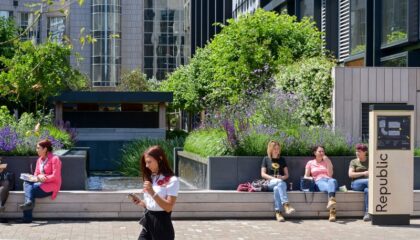Healthy buildings make commercial sense as occupiers return to offices writes Charlotte Ross, one of Workman’s Fitwel Ambassadors.
With investment values underpinned by the successful return to work of occupiers and their staff, property managers and building owners must make workplaces a safe and attractive place for returning occupiers.
The value of health and wellbeing
In the aftermath of the pandemic, the interdependence of occupier wellbeing and real estate asset value is evident. Both occupiers and the real estate industry now show a heightened focus on health and wellbeing. This underscores the integration of wellbeing into development and investment strategies.
Vital for supporting high-performing companies, productive, healthy, and engaged employees play a key role. Successful companies, in turn, assist fund managers in realising and maximising the potential value of real estate assets and services.
Outlined in the Responsible Property Management Toolkit by the Better Building’s Partnership’s, enhancing health and wellbeing offers potential financial benefits. This includes reducing both direct and indirect costs associated with absence and presenteeism.
Certification leads to increased asset value
Buildings certified as healthy attract rents between 4.4% and 7.7% more per sq. ft than their nearby non-certified peers. This is according to ‘The Financial Impact of Healthy Buildings’, research. This research was conducted in December 2020 by the MIT Real Estate Innovation Lab. According to the report, buildings certified by schemes like Fitwel or WELL demonstrate increased financial value. This is irrespective of factors such as building age, renovation or lease duration.
Healthy buildings are perceived as an asset associated with occupier wellbeing and productivity, further enhancing their value to operating businesses. And as companies seek to attract top talent, wellbeing is increasingly prioritised as a fundamental pillar of the ESG strategy. Occupiers are returning and the world is reopening post-pandemic. Health and wellbeing now feature prominently in the ESG framework for evaluating commercial buildings. Consequently, investors must prioritise health and wellbeing in their overall ESG strategy.
Occupiers are scrutinising the workspaces they offer, aiming to align them with their company values and foster a healthy culture. In this evolving landscape, occupier engagement becomes paramount for both employers and investors. This shift prompts asset managers, fund managers, and property managers to adapt to the emerging norms.
The new significance of indoor air quality
The physical characteristics and operational practices within buildings have always exerted significant influence on the health and wellbeing of occupiers. Before the pandemic, the contemporary workforce already had certain health and wellbeing expectations from their workplaces. These encompassed aspects like building design, lighting, amenity space, water provision, quality food services, and fitness activities. Particularly, indoor air quality gained heightened importance due to the impact of Covid.
Ventilation plays a critical role in protecting health and has emerged as particularly important in the context of the Covid-19 pandemic. Indeed, ventilation has been highlighted by University of Cambridge researchers as an essential way of reducing impacts and the spread of the disease.
Today, employees want to be reassured that the buildings and indoor spaces they return to are safe. Indoor air quality requires real-time monitoring and control, actionable insights, and transparency, which can be delivered through technology such as our Intelligent Building Operating System, IBOS.
Various benchmarks and certifications like WELL and Fitwel quantify health and wellbeing provisions in buildings. GRESB incorporating health & wellbeing encourages institutional investors to adopt high standards for global leadership and market differentiation.
Workman’s Wellbeing Asset Plans
With extensive experience and an expansive practical knowledge base at their fingertips, our experts help clients to make sense of the complex health and wellbeing landscape. At Workman, our teams develop effective asset-specific plans to deliver a comprehensive health and wellbeing offering.
In our dedication to exceptional customer experiences, we actively seek opportunities to craft environments that retain occupants. This is by ensuring their employees work in a productive and healthy setting.
Through our Wellbeing Asset Plans, our experts identify and implement health & wellbeing opportunities suitable to each asset and the specific requirements of its occupiers. Initiatives vary from simple schemes such as running clubs, workshops and seminars to larger-scale initiatives such as installing gyms or specialist cycle storage facilities.
To demonstrate the quality of environments their assets offer occupiers, staff and visitors, our experts are advising a growing number of clients to achieve Fitwel certification, “a data-driven certification system which aims to optimise buildings to support occupant health and wellbeing”. The process includes a desktop analysis of the current position of the asset, breaking down initiatives by cost and ease to implement, to ensure clients can see likely outcomes prior to commencement. The process is fully managed from start to certification.
Enhancing Wellbeing: Workman’s approach beyond certification
While Workman can drive standards to meet this certification, our experts can also create Wellbeing Asset Plans based on the same principles, even where certification is not the preferred outcome. The creation and implementation of Wellbeing Asset Plans is led by our dedicated ESG team, who are experienced in working with investors, occupiers, suppliers and other stakeholders to create environments that promote health & wellbeing for all. As members of the Better Buildings Partnership (BBP) Managing Agents Partnership and ISO:14001 accredited, we share an ongoing commitment to the sustainable management of real estate, which we combine with practical advice and implementation.
Read more here about our Wellbeing Asset Plans, ESG services and our in-house publication “Building Wellbeing“




